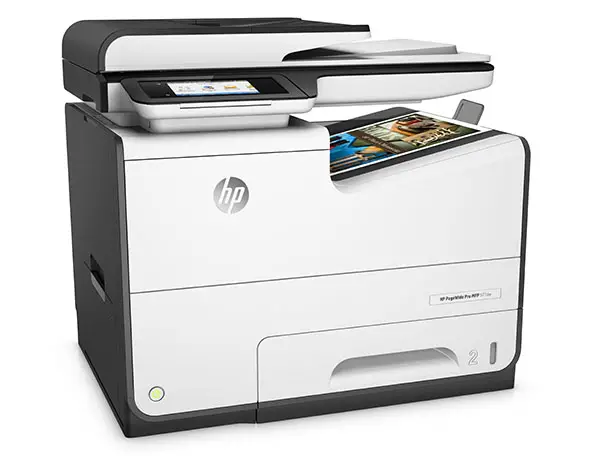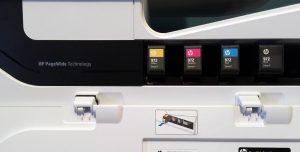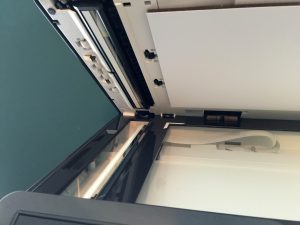The planned follow up to the Ubiquiti UniFi AP deployment/RaspberryPi controller post about running an ELK stack on the controller is on hold; there are no preexisting binaries for the ARM platform and a successful compile from source has eluded me so far. So instead we’re going to walk through setting up an L2TP/IPSEC VPN up on Ubiquiti’s EdgeRouter line of routers. Ubiquiti has a good guide here that will get you 90% of the way there, but is missing a few key pieces of info.
March 2016
 For the first time in forever, HP has birthed a new line and brand of printers – well, sort of. A couple of years go, HP introduced the OfficeJet Pro X line of printers. These printers looked a lot like a LaserJet printer, they were built for business, but the actual print tech was more closely related to an inkjet, and so they were placed in the OfficeJet line. But, there was so much different than other OfficeJet printers. These printers didn’t use a moving print head, they didn’t use the same type of ink and the print speeds were much faster than any other inkjet. This was all enabled because of a print bar that spanned the entire width of the page – something HP dubbed PageWide Technology – and pigmented ink.
For the first time in forever, HP has birthed a new line and brand of printers – well, sort of. A couple of years go, HP introduced the OfficeJet Pro X line of printers. These printers looked a lot like a LaserJet printer, they were built for business, but the actual print tech was more closely related to an inkjet, and so they were placed in the OfficeJet line. But, there was so much different than other OfficeJet printers. These printers didn’t use a moving print head, they didn’t use the same type of ink and the print speeds were much faster than any other inkjet. This was all enabled because of a print bar that spanned the entire width of the page – something HP dubbed PageWide Technology – and pigmented ink.
Fast forward to today and HP has taken the PageWide name and started using it as a brand for large-format printers, including the PageWide XL printer line. PageWide is the both the enabling technology – a stationary print bar that spans the width of the page – and it is also a brand name – a catchy one. With the broader use of the name, HP thinks its is time to rebrand the HP OfficeJet Pro X line to HP PageWide. (I for one, think that’s a smart move.)
So, HP sent me one of the new PageWide Pro 577dw for a test drive. I was lucky to test the OfficeJet Pro X 576dw a couple years ago, so the model I was shipped allowed me to compare the two head to head and see where HP has made some improvements. I wanted to compare the same print jobs head to head on these two printers and clock the differences between them. Those results are near the end, but first, take a look at how the PageWide Pro 557dw is equipped.
PageWide Pro 577dw Specs
- Three print modes
- Professional mode speed: Up to 50 ppm black or color
- General Office mode (fastest mode) up to 70 ppm and Presentation mode (highest quality)
- Scan resolution: Up to 1200 x 1200 dpi hardware and optical
- Copy resolution: Up to 600 dpi black or color (text and graphics)
- Standard connectivity: 2 Hi-Speed USB 2.0 Host; 1 Hi-Speed USB 2.0 Device; 1 Ethernet 10/100 Base-TX network; 2 RJ-11 modem port/phone line; 802.11 b/g/n Station; 802.11 b/g Access Point
- Paper handling: 500-sheet input tray, 50-sheet multi-purpose tray; 300-sheet face-down output bin
- Duty cycle (monthly): Up to 80,000 pages
PageWide Pro 577dw versus OfficeJet Pro X 576dw
- For the 500 series, ink has been relocated into the previously empty space below the output tray — but the PageWide 300 and 400 series are configured like the OfficeJet Pro X 577dw.

- Pro X was rated at 42ppm and the PageWidePro is rated at up to 50 ppm in Professional mode – general office is also faster and the output tray has been redesigned slightly to handle increased speeds – my tests saw better than these advertised speeds, if you deduct the time for the first page to print.
- The duplexing scanner now includes two scan heads – one for front and one for back of page to simultaneously scan – increasing duplex scan speeds tremendously

- Improved Embedded Web Server with AirPrint and Google Cloud Print integration, and HP ePrint and Apps
- Wi-Fi Direct and NFC touch-to-print technology
‘General’ Impressions
Overall the printer firmware is a big improvement over the previous generation. The touch screen seems to be much improved and the ability to move and customize the display is great. There are also new app additions to the onboard software.
Many of the great features of the OfficeJet Pro X made their way on the PageWide Pro including the ability to scan directly from the printer to a network folder, scan to email and scan to SharePoint. These shortcuts are handy as you place the PageWide in walk-up situations. In addition to these shortcuts, you can also walkup and retrieve and print jobs – directly from a USB and from cloud services.
General Office Mode is nothing short of incredible. When printing in the fastest mode, its sort-of like watching to a machine gun fire as the pages come out so quickly (but not as loud). And the quality of the print in General Office mode is still very high quality – not at all what you would expect of a ‘draft’ mode. This is why HP doesn’t refer to this as draft mode – because there is nothing draft about the quality of the print.
Scanning, in particular duplex scanning, is much improved on the PageWide Pro 577dw. The addition of a second scan bar for the document feeder allows for a single pass duplex scanning and also allows for the profile of the document feeder to be slimmed down. The duplexer required in the OfficeJet Pro X 576dw is no longer needed with a second scan bar. This provides up to 5x faster duplex scans without the worry of paper jams due to a cleaner paper path.
Print durability is still incredible in the PageWide Pro 577dw. When I reviewed the OfficeJet Pro X, this was one of the remarkable things about the ink system and the printer in general. The paper would deteriorate under water before the ink would run, particularly with Colorlok paper. I posted about this and even included a video and in testing, this still holds true with the PageWide Pro prints.
As I wrote about back in 2014, the PageWide Pro is a greener alternative to printing, consuming much less power that the laser printer counterparts and also producing less waste than that of many other printers – both laser and inkjet. That tradition continues with the PageWide models. The consumables for this printer only include the cartridges and a waste tray. Comparable laser printers have bulkier toner cartridges with more plastic, fuser kits that have to be replaced during the lifecycle and they consume 50% more energy than the PageWide Pro models.
The PageWide Enterprise models ship with HP SureStart and FutureSmart firmware capabilities along with integration with HP Flow and other enterprise features, but this doesn’t mean the PageWide Pro models are lacking. From a networking perspective, the PageWide Pro supports every major computing platform – from Windows to OS X, iOS and Android in a variety of ways. The PageWide Pro also includes support for 802.1x, SNMP and other enterprise requested features, so it can fit comfortably in a small home network, a branch office, or medium sized business all the way up to the enterprise network.
Where does it fit?
HP is positioning the PageWide lineup between the OfficeJet and LaserJet models. It has compelling DNA from both lines – sharing similar form factors and enterprise-ready features from the LaserJet line and combining those with the economies of ink and a more compelling price point. Below is a lineup for HP’s business printing options and where the company positions each brand.

Speed Tests
| Printer | Pages | Page Type | Job Type | Mode | Time (seconds) | PPM Equivalent |
| PageWide Pro 577dw | 42 | Single | Professional | 56.6 | 44.52 | |
| PageWide Pro 577dw | 42 | Duplex | Professional | 82.64 | 30.49 | |
| OfficeJet Pro X 576dw | 42 | Single | Professional | 62.2 | 40.51 | |
| OfficeJet Pro X 576dw | 42 | Duplex | Professional | 115.47 | 21.82 | |
| PageWide Pro 577dw | 37 | Single | Professional | 50.3 | 44.14 | |
| PageWide Pro 577dw | 37 | Duplex | Professional | 73.29 | 30.29 | |
| OfficeJet Pro X 576dw | 37 | Single | Professional | 51.71 | 42.93 | |
| OfficeJet Pro X 576dw | 37 | Duplex | Professional | 103.1 | 21.53 | |
| PageWide Pro 577dw | 37 | Single | General Office | 32.02 | 69.33 | |
| PageWide Pro 577dw | 37 | Duplex | General Office | 67.89 | 32.70 | |
| PageWide Pro 577dw | 37 | Single | Scan | Color 200dpi | 100.15 | 22.17 |
| PageWide Pro 577dw | 37 | Duplex | Scan | Color 200dpi | 77.29 | 28.72 |
| OfficeJet Pro X 576dw | 37 | Single | Scan | Color 200dpi | 140.1 | 15.85 |
| OfficeJet Pro X 576dw | 37 | Duplex | Scan | Color 200dpi | 310 | 7.16 |
- The times reported include the initial wake-up/warm-up time, once the print job is submitted, until the last page hits the output tray. If this time is removed, these ppm ratings exceed the ppm rating from HP Inc.
Availability and Price
HP expect the PageWide Pro 500 series printers to be available in April, 2016, with a starting price of $699. In addition to the PageWide Pro 577dw multifunction printer, a PageWide Pro 552dw single function printer will be also be available.
Disclaimer: HP Inc. provided the HP PageWide Pro 577dw at no charge for me to review. The views and opinions I share here are my own and were not previously reviewed or dictated by HP.

The slimmed down HP Inc. today unveiled a new lineup of revamped business-focused printers including the introduction of a brand new brand of office printers to be known with the PageWide brand. The announcement is expansive, with the introduction of 15 new printer models and a set of Secure Managed Print services from the company. Packed into the announcement is a major focus on security of printers included in the new print models. Let’s dive into each of the areas in more detail.
Security
There’s a growing concern that devices that make up the Internet of Things (IoT) will become a hotbed for malware and attacks. In fact, 60% of companies have had a data breach involving printers according to the “Insecurity of Network-Connected Printers” study that Ponemon Institute published in October 2015. Updates and patching become incredibly important to secure these devices the same way we have attempted to keep our computers secure.
According to HP, today’s printers more closely resemble computers and are increasingly more connected. Today’s printers aren’t just networked, they have email accounts and are directly connected to the Internet. They are cloud integrated with services backing the choices on the display panels. But even with the innovation and increased capabilities, security has largely been an afterthought, and capable processors and lax security make for a hackers playground. HP realizes this and has been at work with solutions and a change of mindset about printers to try and head off issues.
The first way HP is attempting to address issues is with push updates. The percentage of companies that update printer firmware is small, but HP hopes to change that with a direct from the Internet update capable on new printers. The update feature is powered by software on board the printer, but security professionals may pause and wonder if this is wise to do. Is it possible to simply inject malicious updates and auto-deploy them across an entire enterprise? No so fast, says HP.
The enterprise printers announced today include a security technology called HP SureStart. In September 2015, HP introduced three LaserJet printers that use HP SureStart technology to protect the printer’s BIOS. If the HP SureStart name sounds familiar, it is a security feature that was introduced into the HP Elitebook line of professional laptops back in 2014, that HP has brought to its printer lineup.
HP SureStart is a secure BIOS that stores both the current and a previous version of the BIOS. SureStart detects tampering and malware attacks on the BIOS and will revert to saved, good BIOS version to ensure that the basic firmware of the hardware is not compromised. HP calls it self-healing.
Not only are the updates meant to be for security, they also provide a consistent user interfaces across the printer fleet. HP FutureSmart is a push from HP to establish a consistent user experience across all of its enterprise printers and enable the same walk-up features no matter where you go in the organization and this capability is also included in the enterprise printers announced today.
Secure Managed Print Services
Building on the HP SureStart, HP has created an ensemble of services to create Secure Managed Print Services. The self-healing capabilities of the printers with HP SureStart is the foundation of the secure print services, but it also combines security software to detect threats, protect, monitor and manage the printer fleet and provide reporting for regulatory and compliance audits. Secure Managed Print Services also includes a strong component of security consulting from the experts at HP to device a comprehensive print security plan. Finally, the services also allow for data encryption to provide protection for confidential information.
As part of the announcement, HP introduced an updated version of HP JetAdvantage Security manager, a software that allows for policy-based printer security. This software provides much of the reporting, auditing and compliance enforcement capabilities for the Secure MPS.
HP also announced that its Enterprise printers will now be able to be monitoring using Splunk.
HP PageWide Printers
In perhaps the biggest news, HP introduce a new brand of printers – the HP PageWide line. PageWide has been used by HP to describe the printing technology of the HP OfficeJet Pro X line as well as the brand name of some specialty large-format printers, like the PageWide XL line, over the last several years. Now, HP is borrowing the name of its wide print bar to be the brand name for the printers that use it.
PageWide printers will come in two major categories – Pro and Enterprise. HP introduced two PageWide Enterprise printers today – the PageWide Enterprise Color 586 multifunction and the PageWide Enterprise Color 556 single function printer. Enterprise models will be the most full featured models and include options to essentially replace copiers and multifunction with floor stands and other accessories. There are also additional software capabilities in the Enterprise models, including integration with HP Flow print control services.
The PageWide Pro models will be focused on small to medium business and branch office solutions and are split into 3 series – the 300, 400 and 500 series. The major difference between each series is speed. The 300 series features printers with up to 30 pages per minute (ppm) in Professional print mode and 45 ppm in General Office mode (HP PageWide’s version of draft mode – but don’t think low quality here – it is still very high quality). The 400 series features 40 ppm in Professional print mode and 55ppm in General Office mode. While the fastest printers are in the 500 series, rated at 50 ppm in Professional and 70 ppm in General Office mode. The 500 series also offers a series of accessories to convert the printer into a floor model with additional drawers for paper types and job accounting and PIN printing on the front console. All of the new PageWide Pro printers feature a single-pass duplexing scanner rated at 26 ppm. HP has released a multifunction printer and single-function printer in each series today.
The new PageWide brand will replace the Pro X moniker that HP initially introduced for its business-class printers using the PageWide print bar. The new brand will differentiate the print technology that uses the wide print bar and pigment inks versus all of its business ink printers in the OfficeJet line that use moving print heads and traditional inks. HP sees the PageWide brand sitting in between the LaserJet and OfficeJet families – providing the lowest cost per page of any of its business-class printers, along with the least amount of waste generated and least amount of energy used.
Below are slides with details of the new printers are below to provide more information for the entire lineup:
OfficeJet Pro Additions
HP also introduced several new models in the OfficeJet Pro category, targeted at small business with up to 5 users sharing a printer. These print models target small office environments and specific use cases, such as legal documents and mobile printing. All of the new OfficeJet printers announced replace existing models that HP is retiring in the lineup. Details on the models and their specs in the slides below.
For the LaserJet line, HP introduced two new printers today – the HP LaserJet Pro M501 – a monochrome laser printer targeted at 5 to 15 users and the HP Color LaserJet Pro MFP M377dw – targeted at 3 to 10 users with multifunction capabilities. Both are brand new products, not replacing existing products in the lineup.

